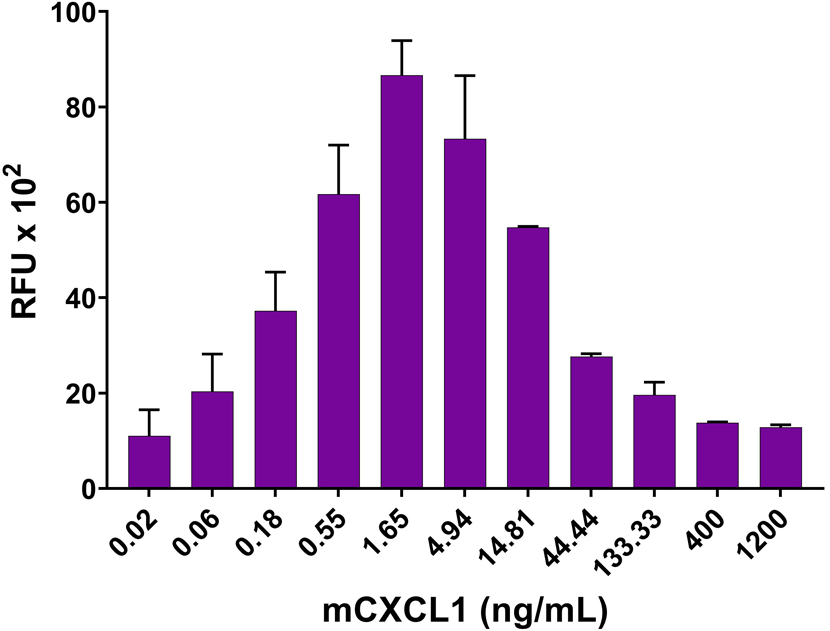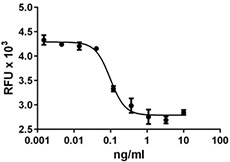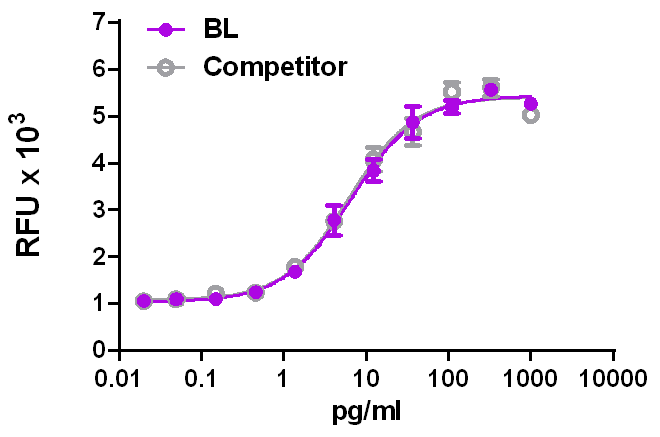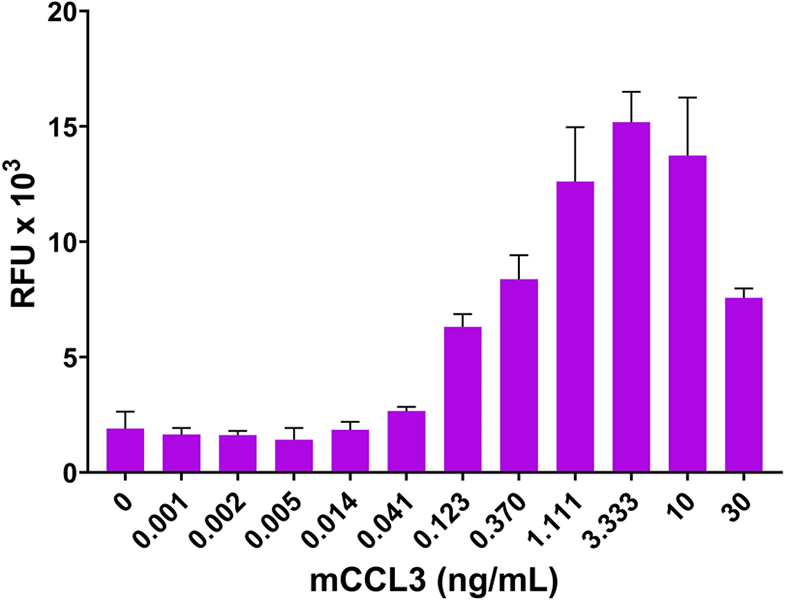- Regulatory Status
- RUO
- Other Names
- Gro2 oncogene, Groβ
- Ave. Rating
- Submit a Review
- Product Citations
- 1 publications

| Cat # | Size | Price | Save |
|---|---|---|---|
| 582502 | 10 µg | ¥29,260 | |
| 582504 | 25 µg | ¥50,350 | |
| 582506 | 100 µg | ¥136,520 |
CXCL2 is an ELR CXC chemokine, and it is structurally and functionally related to GRO1 (CXCL1), GRO3 (CXCL3), and interleukin-8 (CXCL8). CXCL2 binds to the CXCR2 receptor, and this receptor is shared with other ELR CXC chemokines (CXCL1, CXCL3, CXCL5, CXCL6, CXCL7, and CXCL8). CXCL2 is highly expressed in esophageal squamous cell carcinoma (ESCC), and it has been detected in serum of patients with this disease. Also, CXCL1, CXCL2, and CXCL3 have been shown to be highly expressed in patients with malignant melanoma. In addition, CXCL2 and CXCL1 are up-regulated in the central nervous system in multiple sclerosis (MS) and in the animal model of experimental autoimmune encephalomyelitis (EAE). In EAE, it has been shown that transfer of encephalitogenic CD4+ Th17 cells induce CXCL1 and CXCL2 transcription in the spinal cords of naïve, syngeneic recipients. IL-17 is a potent inducer of ELR+ CXC chemokines in MS and EAE. In fact, it has been showed that CXCL1 and CXCL2 are up-regulated in the preclinical and clinical stages of EAE. In addition, it has been shown that CXCL1 and CXCL2 are secreted by ephithelial cells in bone marrow, and CXCL2 is secreted by endothelial cells during G-CSF-induced neutrophil mobilization.
Product DetailsProduct Details
- Source
- Mouse CXCL2, amino acids Ala28-Asn100 (Accession# NM_009140.2) was expressed in E. coli.
- Molecular Mass
- The 73 amino acid recombinant protein has a predicted molecular mass of approximately 7.8 kD. The DTT-reduced protein migrates at approximately 10 kD and non-reduced protein migrates at 12 kD by SDS-PAGE. The N-terminal amino acid is Alanine.
- Purity
- >98%, as determined by Coomassie stained SDS-PAGE.
- Formulation
- 0.22 µm filtered protein solution is in PBS.
- Endotoxin Level
- Less than 0.01 ng per µg cytokine as determined by the LAL method.
- Concentration
- 10 and 25 µg sizes are bottled at 200 µg/mL. 100 µg size and larger sizes are lot-specific and bottled at the concentration indicated on the vial. To obtain lot-specific concentration and expiration, please enter the lot number in our Certificate of Analysis online tool.
- Storage & Handling
- Unopened vial can be stored between 2°C and 8°C for up to 2 weeks, at -20°C for up to six months, or at -70°C or colder until the expiration date. For maximum results, quick spin vial prior to opening. The protein can be aliquoted and stored at -20°C or colder. Stock solutions can also be prepared at 50 - 100 µg/mL in appropriate sterile buffer, carrier protein such as 0.2 - 1% BSA or HSA can be added when preparing the stock solution. Aliquots can be stored between 2°C and 8°C for up to one week and stored at -20°C or colder for up to 3 months. Avoid repeated freeze/thaw cycles.
- Activity
- Bioactivity was measured by its property to chemoattract human neutrophils in a dose dependent manner. Recombinant Mouse CXCL2 chemoattracts Baf3-mCXCR2 transfectant cells in a dose-dependent manner with ED50 range of 0.1 - 0.5 ng/mL.
- Application
-
Bioassay
- Application Notes
-
BioLegend carrier-free recombinant proteins provided in liquid format are shipped on blue-ice. Our comparison testing data indicates that when handled and stored as recommended, the liquid format has equal or better stability and shelf-life compared to commercially available lyophilized proteins after reconstitution. Our liquid proteins are verified in-house to maintain activity after shipping on blue ice and are backed by our 100% satisfaction guarantee. If you have any concerns, contact us at tech@biolegend.com.
- Product Citations
-
Antigen Details
- Structure
- Chemokine.
- Distribution
-
Macrophages, monocytes, fibroblasts, intestinal enterocytes, bone marrow endothelial cells, osteoblasts, and epithelial cells.
- Function
- CXCL2 chemoattracts and activates neutrophils, and it plays a key role in neutrophil mobilization from the bone marrow. CXCL2 is induced by TNFα, IL-1α, IL-17, and LPS.
- Interaction
- Neutrophils, basophils, lymphocytes, monocytes, keratinocytes, hematopoietic cells, endothelial cells, bone marrow endothelial cells, osteoblasts, epithelial cells, fibroblasts, melanoma cells, melanocytes, and neurons.
- Ligand/Receptor
- CXCR2.
- Biology Area
- Cell Biology, Signal Transduction
- Molecular Family
- Cytokines/Chemokines
- Antigen References
-
1. Haskill S, et al. 1990. P. Natl. Acad. Sci. USA 87:7732.
2. De Plaen I, et al. 2006. Immunology 118:153.
3. Carlson T, et al. 2008. J. Exp. Med. 205:811.
4. Eash KJ, et al. 2010. J. Clin. Invest. 120:2423.
5. Keeley EC, et al. 2011. Exp. Cell. Res. 317:685.
6. Onishi RM and Gaffen SL. 2011. Immunology 129:311. - Gene ID
- 20310 View all products for this Gene ID
- UniProt
- View information about CXCL2 on UniProt.org
Related FAQs
- Why choose BioLegend recombinant proteins?
-
• Each lot of product is quality-tested for bioactivity as indicated on the data sheet.
• Greater than 95% Purity or higher, tested on every lot of product.
• 100% Satisfaction Guarantee for quality performance, stability, and consistency.
• Ready-to-use liquid format saves time and reduces challenges associated with reconstitution.
• Bulk and customization available. Contact us.
• Learn more about our Recombinant Proteins. - How does the activity of your recombinant proteins compare to competitors?
-
We quality control each and every lot of recombinant protein. Not only do we check its bioactivity, but we also compare it against other commercially available recombinant proteins. We make sure each recombinant protein’s activity is at least as good as or better than the competition’s. In order to provide you with the best possible product, we ensure that our testing process is rigorous and thorough. If you’re curious and eager to make the switch to BioLegend recombinants, contact your sales representative today!
- What is the specific activity or ED50 of my recombinant protein?
-
The specific activity range of the protein is indicated on the product datasheets. Because the exact activity values on a per unit basis can largely fluctuate depending on a number of factors, including the nature of the assay, cell density, age of cells/passage number, culture media used, and end user technique, the specific activity is best defined as a range and we guarantee the specific activity of all our lots will be within the range indicated on the datasheet. Please note this only applies to recombinants labeled for use in bioassays. ELISA standard recombinant proteins are not recommended for bioassay usage as they are not tested for these applications.
- Have your recombinants been tested for stability?
-
Our testing shows that the recombinant proteins are able to withstand room temperature for a week without losing activity. In addition the recombinant proteins were also found to withstand four cycles of freeze and thaw without losing activity.
- Does specific activity of a recombinant protein vary between lots?
-
Specific activity will vary for each lot and for the type of experiment that is done to validate it, but all passed lots will have activity within the established ED50 range for the product and we guarantee that our products will have lot-to-lot consistency. Please conduct an experiment-specific validation to find the optimal ED50 for your system.
- How do you convert activity as an ED50 in ng/ml to a specific activity in Units/mg?
-
Use formula Specific activity (Units/mg) = 10^6/ ED50 (ng/mL)




















Follow Us